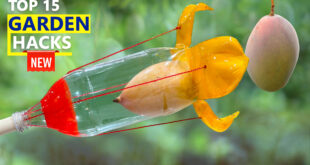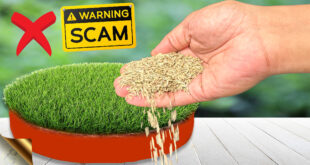In Today’s post, let us learn some easy tips and tricks on how to successfully grow Chilli Peppers at home in containers and how to get a better yield growing chillies in containers.
Chili Peppers is a warm weather vegetable and can be easily grown in containers.
- CHOOSING THE VARIETY: There are literally dozens of chili pepper varieties. Each type varies in taste, size and shape. Mildest type is Bell Pepper or capsicum. So, these tips are common for all varieties of chilly peppers.
- SEED SOWING: Chilli Peppers grows best in warm conditions. Right time to plant seeds is when the soil temperature is 70 – 85 degrees Fahrenheit (20 to 30 Celsius). You need to choose a mature seed pod to grow chilli peppers like the red one. Green pods are still immature and may show poor germination results.
You can sow the seeds first in a small container or seedling trays and then go for transplant after 4 to 6 weeks. In any case, the depth of sowing should not be more than 5 mm. The seed starting mix should have at least 50% compost like vermicompost or decomposed cow dung in it. They usually germinate in 1 to 2 weeks.
You can transplant these after 4 – 6 weeks.
- CHOOSING THE CONTAINER: You can easily grow Chilli Peppers in small containers. Its ideally grown in a 12 inch container. You can use good quality plastic pot or a cement pot or a grow bag.
- POTTING SOIL MIX: A well-draining soil is very important for healthy root growth. A simple well draining potting mix should include: 30 – 40 percent garden soil, 30 – 40 percent Coco-peat or peat moss and 20 – 30 percent compost like decomposed cow dung or vermicompost.
- SUPPORT / STAKING: Installing stakes or supports is helpful especially if they load up with fruits. You can use sticks or pipes tp support them. You can also tie strings to support the main stem.
- SUNLIGHT / LOCATION: Chilli Peppers need full direct sunlight of at least 6 hours for flowering and fruiting. Also keep them in a spot where pollinator insects like butterflies and honeybees visit frequently. Otherwise they will fail to produce fruit and result in flower drop off.
- WATERING: Give Chili Peppers a steady supply of moisture, but do not let the soil get soggy. Daily watering is the general rule and whenever you are watering, water it deeply and thoroughly so that entire root system is drenched with water. Improper watering can result in flower or fruit drop off.
- FERTILIZERS: Firstly during transplant adding a some amount of phosphorous source like bone meal powder or organic rock phosphate will really help the plant to induce lot of flowering and fruiting and also confers resistance to pests and diseases like the leaf curl virus. These two organic fertilizers are very important slow release sources of phosphorous which makes the roots stronger which in turn makes the plant grow healthier and yield better by boosting the plant immune system or resistance against pests and disease.
Secondly, A handful of compost like decomposed cowdung or vermicompost or both once every 15 days is the minimum requirement for Chilli Peppers. You can double this frequency or amount in flowering stage.
Then, adding some source of calcium like gypsum or lime or even finely powdered egg shells is also beneficial especially during fruiting stage.
- PEST CONTROL: Chilli Peppers is occasionally affected by pests like mealybugs, aphids and white flies. Leaf curl Virus needs a special mention. If the plant is affected by leaf curl virus, better to discuss the plant so that other plants are not infected.
Best is prevention by spraying neem oil once in 15 days. 5 to 10 ml neem oil plus some liquid soap in one litre of water is the recommended dosage. If it’s already infested, you can spray weekly once or even twice until all pests are eradicated. Make sure you do a patch test on a leaf before spraying on the entire plant.
- PRUNING or TRIMMING: Trimming promotes branching and this in turn produces more flowers and more fruits.
One important tip here: When the plant is about six to 8 inches tall, pinching the growing tip will result in a bushier plant and also remove any flowers that appear early, as the early flowers diminish the plants overall energy.
HARVESTING CHILLI PEPPERS: You can harvest chilly peppers anywhere between 60 to 100 days after planting.
 GKVKs – Gardening Tips and Store Gardening Tips and Store
GKVKs – Gardening Tips and Store Gardening Tips and Store



